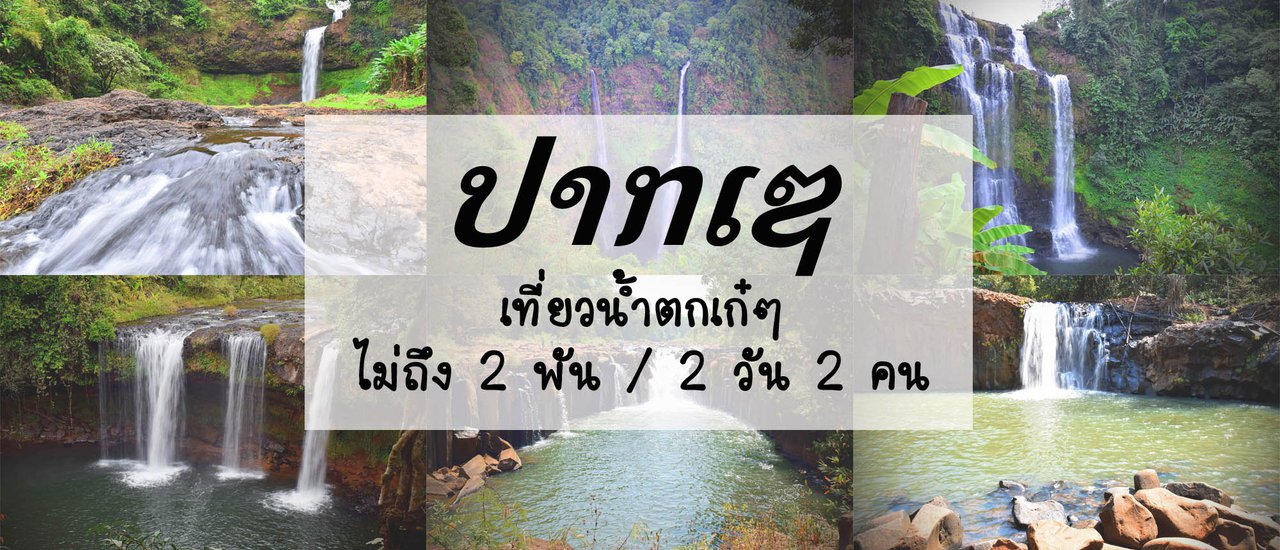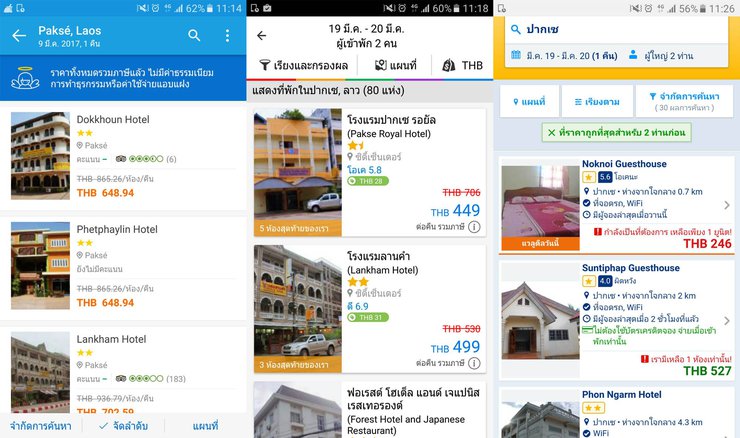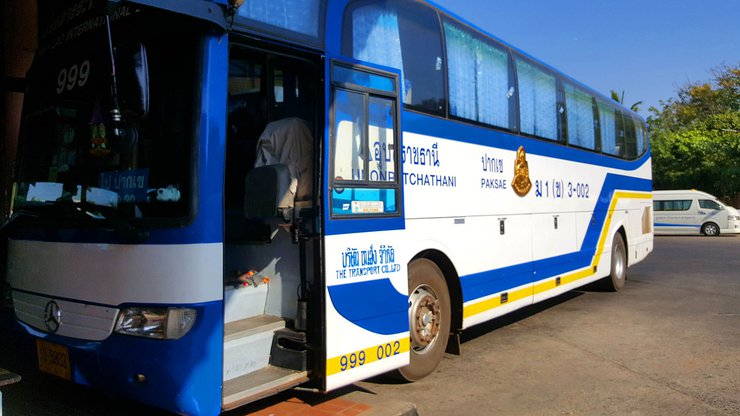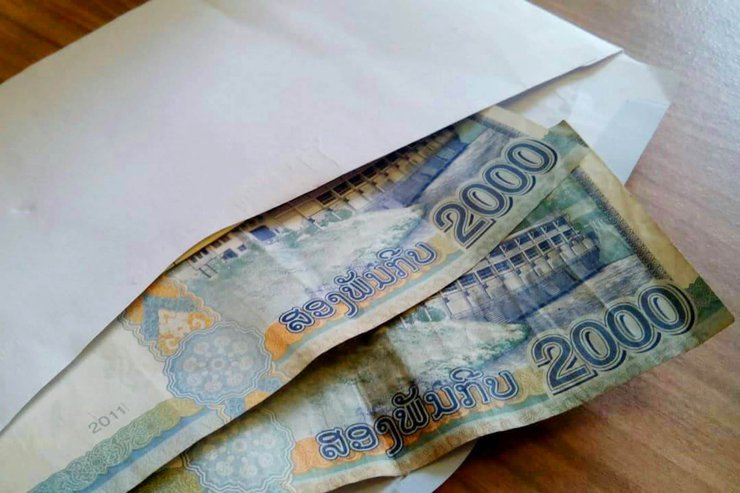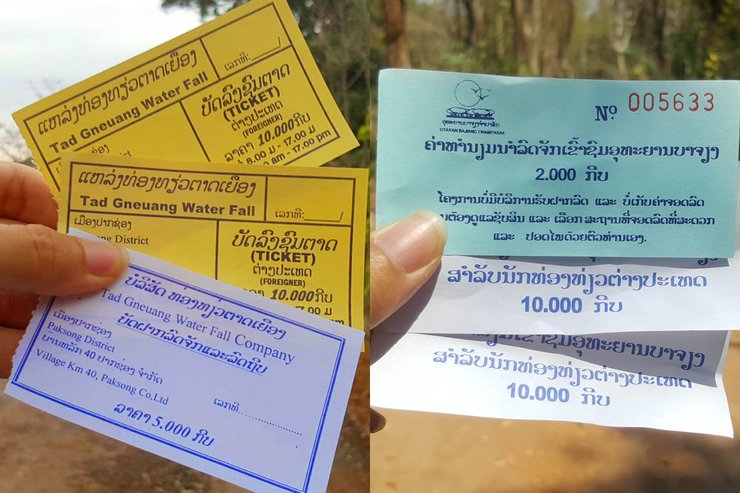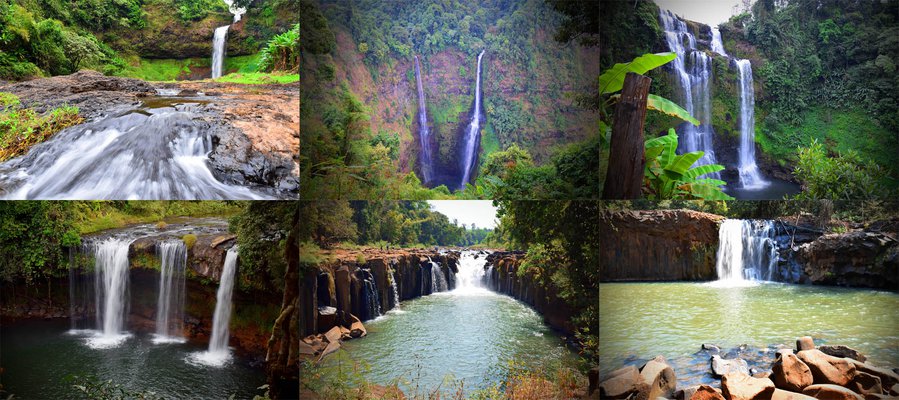Pakse: Explore Stunning Waterfalls for Under $200 (2 Days, 2 People)
7 Things to Know Before Visiting Pakse, Laos
This trip to Laos was limited by both time and money, so the focus was on visiting waterfalls near Pakse. The waterfalls in Pakse are quite large and boast a high level of natural abundance. However, before embarking on your journey, here are 7 things you should know about Pakse:
7 Things You Should Know Before Visiting Pakse
1. Introduction to Pakse (Lao: ປາກເຊ) is the capital of Champasak Province, located on the banks of the Mekong River and at the confluence of the Xe Don River. It is considered the economic center of southern Laos, often referred to as "Southern Laos." The year-round temperature averages between 15-35 degrees Celsius, similar to Thailand. The coolest months are December and January, with temperatures below 20 degrees Celsius. March and April are the hottest, with temperatures exceeding 30 degrees Celsius. The rainy season lasts from May to October. Major tourist attractions include waterfalls, known as "Tad" in Lao, unique Lao temples, and the Wat Phu temple complex, a UNESCO World Heritage Site.

2. Transportation: From Thailand, you can cross the border at Chong Mek, Ubon Ratchathani Province, and follow Laos Highway 10. Cross the Laos-Japan Friendship Bridge over the Mekong River. There are buses from Ubon Ratchathani to Pakse twice a day, at 9:30 AM and 3:30 PM. The distance from Pakse to Chong Mek is 44 kilometers. Currently, the bus will go to the "Kriangkai Transport" station. For the return trip, there are also two buses at the same time as the outbound trip. If you miss the bus, there are also vans from Ubon to Chong Mek. The van will only take you to the border crossing, and then you will need to take another van from the border to Pakse. The fare for each leg is 100 baht, and there are many departures.

3. Currency The official currency of Laos is the kip. The kip is significantly weaker than the Thai baht, but the cost of living in Laos is high. While Laotians use kip for everyday transactions, they often use thousands of kip at a time. Therefore, when exchanging Thai baht for kip, the large numbers (tens of thousands or even hundreds of thousands) may give the impression of having a lot of money. However, when spending, the money disappears just as quickly as spending hundreds or thousands of baht in Thailand.
The exchange rate on February 18-19 is 238.16. To exchange Thai baht, simply multiply the desired amount by the exchange rate. For example, to exchange 1,000 baht, you would receive 238,000 kip. To estimate the exchange rate, you can use the formula: Kip (remove the last three digits) x 4 = approximate baht value. For example, 1,000 kip would be approximately 1 x 4 = 4 baht. For a precise result, use the formula: Kip divided by the exchange rate. For example, 1,000 kip is equal to 1,000 ÷ 238 = 4.20 baht.
* Note At the Laotian border crossing, Lao people may approach you to exchange kip, but at a significantly lower rate. It is recommended to walk to the bank, which is located opposite the checkpoint, or ask for "Thanakan".

4. Currency Denomination in Laos
In Laos, the currency is denominated in "kip" (1,000 kip) for each transaction. When writing numerals, Laotians use a period (.) instead of a comma (,) as in Thai. When pronouncing the amount, they typically state the number before the decimal point followed by the word "พัน" (thousand). For example:
- 1,000 kip = หนึ่งพันกีบ (One thousand kip)
- 10,000 kip = สิบพันกีบ (Ten thousand kip)
- 100,000 kip = ร้อยพันกีบ or หนึ่งร้อยพันกีบ (One hundred thousand kip)
However, 20,000 kip is pronounced as "ซาวพันกีบ" ("ซาว" meaning twenty, similar to the usage in northern and northeastern Thailand). Some Laotians may use the Thai pronunciation for ease of understanding, such as พันกีบ (thousand kip), หมื่นกีบ (ten thousand kip), and แสนกีบ (one hundred thousand kip).

5. Accommodation: Most hotels are located in Pakse city center, with prices ranging from 300 baht to several thousand baht. For cheaper options, guesthouses are available. You can compare prices and book your accommodation in advance on various Thai booking websites to avoid carrying extra cash.

6. Food Pakse offers a diverse range of dining options, from traditional pho restaurants and local eateries to international cuisine and fine dining establishments. Prices start from 10,000 kip per dish, with the average cost of a meal ranging from 10,000 to 15,000 kip.
There are no areas with multiple shops located close together. Convenience stores are very difficult to find. There are no grocery stores, and it is almost impossible to find any kind of bakery. To find shops, you need to go to the market. There are two markets: the weekend market and theดาวเรือง market, which Lao people call the "shopping mall" market.

7. Internal travel
- For tuk-tuks, skylabs, or three-wheeled trailers, it is recommended to negotiate the price before boarding. If you are only traveling within the city, try to bargain for around 10,000 kip. Ideally, you should not pay more than 20,000 kip. If the quoted price is higher, do not accept it as it is considered expensive.
- Motorbike rental prices typically range from 60,000 kip per day for standard rentals and 50,000 kip per day for rentals exceeding two days. Automatic transmission motorbikes cost approximately 100,000 kip per day. Motorbikes must be returned by 8:00 PM to avoid incurring additional charges. Unlike in Thailand, a 24-hour rental period does not apply. However, if the rental begins between 2:00 PM and 3:00 PM, a 24-hour rental period can be negotiated. Only a passport is required for rental. It is crucial to be familiar with Lao traffic regulations. The most important rule is to drive on the right side of the road, opposite to Thailand. Pay close attention to traffic lights, including green (free) and red (authority) lights. Observe road signs and direction signs carefully. Lao language signs are generally understandable, and some signs have English translations. At some intersections, traffic lights indicate that vehicles traveling straight do not need to wait for the signal, similar to the "left turn on green" rule in Thailand.
- Most vans can inform the accommodation to contact them, just inform the desired destination.
Tourist Precautions:
Prohibited Activities:
- Photography of sensitive locations: This includes military bases, radar stations, and other security-related sites. Violators will face legal consequences, including imprisonment and fines.
Additional Information:
This information provides a basic understanding of restrictions before traveling to Pakse.
Let's embark on our journey!
The starting point of this journey
A Serendipitous Trip to Pakse: From Ubon Ratchathani to Southern Laos
The journey began with two round-trip tickets to Ubon Ratchathani on Nok Air. After confirming the flight times and finding suitable travel companions, the group turned their attention to planning their itinerary within the province. A long list of desired destinations emerged, accompanied by map consultations and transportation considerations. Then, one of the companions proposed, "Why not go to Pakse?"
This unexpected suggestion sparked a brief internal debate. While the group had meticulously researched destinations like Haad Chom Dao, Wat Rueang Saeng, Sam Phan Bok, and Pattaya Noi, Pakse remained unexplored territory. However, the proximity and the allure of a new adventure outweighed the initial hesitation. With a unanimous decision, the plan shifted towards Pakse, leaving the nearby attractions for a future visit.
With the destination confirmed, the excitement grew palpable. It was time to pack their bags and embark on this serendipitous journey to southern Laos.

Due to our limited vacation days as company employees who work two Saturdays per month, we had to plan our trip carefully. We booked flights in advance and decided on a two-day, one-night trip (including a Saturday workday). With limited time, we had to prioritize and postpone destinations that required more travel time. This resulted in the "Pakse: Cool Waterfall Tour Under 2,000 Baht / 2 Days 2 People" trip, focusing on waterfalls, or "Tad" in Lao, near Pakse.
- E-Tu Waterfall
- Tad Fane Waterfall
- Gneuang Waterfall
- Thum Jum Pee Waterfall
- Tad Pha Souam (Waterfall of the Thousand Swallows)
- Makang Waterfall
- Stay in the city

Day One
The 7:25 a.m. flight departs from Don Mueang Airport. Passengers can check in online with Nok Air between 24 hours and 1 hour before departure. Therefore, there is no need to rush to the airport as you can print your boarding pass in advance. Just pay attention to the boarding time or the time specified on your boarding pass, as this is the time when the staff will call passengers to board the plane. Upon arrival at the airport, you can walk directly inside.
Attention! If you are currently at Don Mueang Airport and use a TrueMove H mobile phone, you can walk into a Burger King restaurant and dial the number displayed on the sign to receive a free burger set. This offer is limited to one set per month per person. (Why am I using advertising language?!)

AIS Serenade Gold members enjoy a complimentary beverage each month. In addition to Burger King, numerous other airport restaurants offer exclusive benefits. (Customers can check their privileges: TrueMove users can check the TrueYou app or website by searching for "airport"; AIS members can check the following link: http://www.ais.co.th/serenade/privileges-detail.aspx?spid=17&language=th). Remember, we have special privileges!)
We managed our time well and arrived at the gate with plenty of time to spare. We relaxed and chatted for a while before it was time to board the plane.

I have traveled many times, but this is only my second time flying with Nok Air.

While waiting for other passengers to board, I enjoyed reading the JIBjib magazine. This issue featured "The King's Heart to the Mountains: Following in the Footsteps of the Monarchy in Chiang Rai." As our next trip will be to Chiang Rai, I took the opportunity to gather more information.

Shortly after takeoff, snacks were served. The best part was the water bottle, which was tiny and adorable.

From Don Mueang Airport to Ubon Ratchathani Airport, it takes about 1 hour. Our next destination is the bus station. We need to catch the Ubon Ratchathani - Pakse bus at 9:30 AM. By taking a metered taxi for only 60 baht, we arrived at the bus station with plenty of time to spare.

Approaching the counter labeled "International Bus Tickets: Ubon Ratchathani - Pakse," the individual presented cash and a passport to purchase a ticket for 200 baht.

Following the directions, I arrived at Platform 2, where the "Ubon Ratchathani - Pakse" bus was conveniently parked. It was the one with the sign "THAI - LAO INTERNATIONAL BUS." With a cheerful expression, I approached the bus staff and presented my ticket, saying, "To Pakse, please." The friendly staff member, with a service-oriented attitude, responded, "Please board the bus. I will find you a seat."

At approximately 9:40 AM, the tour bus slowly began its journey towards the Chong Mek border crossing. After a two-hour drive, we arrived at the Thai immigration checkpoint. Shortly before reaching the checkpoint, the bus stopped, and an official informed passengers without passports that they needed to obtain a temporary 30-baht boarding pass for entry into Laos (valid for 3 days). Passports allow for a one-month stay. A few minutes later, the bus stopped again, and the same official instructed everyone to disembark for immigration procedures. Starting at the Thai checkpoint, we picked up immigration forms, filled them out for both arrival and departure, and presented them to the immigration officer along with our passports. After verifying the information, the officer removed the departure portion and stapled the arrival portion into our passports.

From here, walk down the tunnel to the Lao border checkpoint, which is about 700-800 meters away. After a short walk, you will reach the Lao immigration office. Fill out both sections of the Lao immigration form carefully.

The applicant should submit their passport and the fee. Based on my research, the fee is not 40 or 20 baht as previously reported. The officers are aware of these amounts and will inform the applicant that the fee is 100 baht before submission.

After completing the immigration process, walk to the bank across the street from the checkpoint to exchange money. The exchange rate is 238. If you exchange money with the Lao people who approach you, the rate will be lower.

Exchanged 1,000 baht for 238,000 kip, adding to the 50,000 kip remaining from our previous trip.

This place also sells phone SIM cards. From what I understand, 100 baht will get you one week of free internet with a validity period of one year. As for me, I can wait to use the Wi-Fi at my accommodation. I'm not too worried about this.
After traveling for almost an hour, we arrived at the bus station, "Kriangkai Transport," located a considerable distance from the city center. Although we could have gotten off in the city, we decided to continue to the bus station to familiarize ourselves with the location for our return trip. Upon arrival, we purchased our return bus tickets for 200 baht each and immediately sought transportation into the city. Two-wheeled taxis were readily available, and without prior knowledge of local fares, we paid 20,000 kip each. Alternatively, payment in Thai baht was 100 baht (paying in kip was cheaper). A fellow traveler remarked, "I heard them say nine thousand kip, so we quickly got on the vehicle." The issue was that we had entrusted a fellow traveler with researching this aspect. Several older reviews suggested negotiating a price of around 40 baht (but we ended up paying over 80 baht!). Upon hearing this, I immediately realized, "Did they say 'saow pan kip' and you misheard it as 'kao pan kip'? Saow pan kip is equivalent to twenty thousand kip." Hahahaha!
Today, we will visit the waterfalls located on the same route as shown in the map.

The accommodation for tonight has been booked in advance with a slight discount. The price is 390 baht. "Royal Pakse Hotel" (address 242 Ban Lakmuang, Road 13, Champasack, Lao). The reason for choosing this place is because it is located in the city, making it easy to find restaurants and is affordable.
There was a motorbike rental shop right in front of the hotel, but there were no bikes available to rent. "There are a lot of people visiting today. A lot of people from your town have come, and a lot of foreigners have been renting bikes since yesterday. I'm wondering if it's a holiday in your town," said the Laotian man sitting at the rental desk (he spoke Thai so clearly that you wouldn't know he was Laotian if he didn't tell you). This caused a delay, so we asked him to hold a bike for us if anyone returned one. We then checked into our room. The room had a few drawbacks: the TV wouldn't turn on, the window screen was broken, and the bathroom exhaust fan was noisy. Other than that, it was comfortable enough. The price was reasonable.

After leaving our luggage, washing our faces, and preparing to go out, we went downstairs and saw two rental cars. We immediately booked one. The rental company kept our passports and charged 60,000 kip per day. Initially, they told us it wasn't 24 hours, and we had to return the car by 8:00 p.m., which is one day. We started to express our opinion, "Oh, it's not 24 hours? But we didn't rent it in the morning. We only have a few hours left, and we have to return the car already? But you will charge us the full price of 60,000 kip? We are all fellow countrymen, so you should be more accommodating." Another young man continued, "If you had rented it around two or three in the afternoon, we could have given you 24 hours. But it's really not possible. We usually charge this price." As soon as we heard that sentence, we picked up our phone to check the time. "Oh, it's almost two o'clock now," we said. The young man was stunned. He might have thought to himself that he shouldn't have said that... or maybe not. In the end, we rented the car for 24 hours for 60,000 kip (about 250 baht). There was no fuel, only a little left in the tank, so we had to find a gas station to fill up before our long journey.

Our first destination was "Ta Dee Tu", not far away. But before we arrived, our stomachs started to growl, signaling that we needed to eat something. Haha! As soon as we left the city center, it became difficult to find restaurants. But soon after, we spotted "Chai Si Kiew" restaurant on the opposite side of the road.

Without further ado, let's stop by. The price is reasonable at 15,000 kip per bowl.

The special dish costs 20,000 kip, which is a lot. Pepsi is 5,000 kip and tastes acceptable. This meal cost 40,000 kip in total.

With full stomachs, we were ready to continue our journey. The road was under construction for most of the way, and the dust was intense. We recommend bringing a face mask to protect yourself. At times, the dust was so bad that we had to cover our noses with our shirts. Along the way, we saw shops selling woven goods such as sticky rice containers and pot lids. Some shops had large jars, but we weren't sure if they contained alcohol or fermented fish paste.

Passing through a PTT gas station and a coffee factory, we soon reached a large intersection with fruit stalls selling bananas, watermelons, and other produce on both sides. While turning left here would lead to Tad Pha Suam, we continued straight ahead. Shortly after, we arrived at the entrance to "Tad E Tu".

"From Pakse, take Highway 13 and then Highway 16E east towards Pakxong. Before kilometer 38, there will be an entrance on the left. Continue for about 1 kilometer. The total distance is approximately 38 kilometers. It is located within the Tad E-Tu Resort."

The area offers restaurants and parking for tourists. The entrance fee to the waterfall is 5,000 kip per person. The descent is a cemented staircase, which can be quite a climb.

As you descend, you will see a vast expanse with a gentle stream meandering through it.

A sign indicates that the right path leads to the first waterfall, while the left path leads to the second and third waterfalls.

The first tier of the waterfall, a magnificent creation of nature, unfolded before our eyes.

We enjoyed this place. It has a high degree of natural beauty. The waterfall flows down from a high cliff, and there are pools where you can swim. The water is very clear.

However, during the rainy season, the area is prone to flooding, making it unsafe for swimming. Due to time constraints, we were unable to visit the second and third tiers of the waterfall and had to continue our journey to another destination.

"From Tad E-Uan, continue on Highway 16E for another 2.5 kilometers towards Pak Song. At kilometer marker 38, you will find the entrance to Tad Fane on your right."

Turn in for another 1 kilometer and you will find the path to the waterfall. The entrance fee is 5,000 kip per person and the parking fee for motorcycles is 3,000 kip.

Accommodation is also available here, with several restaurants and stalls in front.

Tad Fane is the highest waterfall in Champasak Province, also known as Dong Huasao Waterfall ("Fane" means "barking deer"). It is a massive waterfall with two streams cascading down a ravine of over a hundred meters. The viewpoint we are at is located on the opposite side of the waterfall, offering a distant perspective.


During the rainy season, a magnificent waterfall emerges, with water cascading down from both sides. The left side originates from Huai Phak Kut, while the right side flows from Dong Hua Sao National Park, both at similar elevations. Visitors can hike down to the base of the waterfall for a closer look, but the journey is lengthy. It is recommended to bring food, camping equipment, and spend a night at the bottom before returning the next day. Contacting park officials for information about the trail and safety precautions is highly advised.

A close-up zoom to showcase the ethereal beauty of the doe's eyes.

We spent less than 15 minutes here before moving on. Goodbye, Mother Hen and little chicks.

The next station is "Tad Yeuang", located near Tad Fan. Follow Highway 16E until kilometer 40, where you will find a sign for the waterfall on the right-hand side.

After about 1 kilometer, you will reach the entrance gate. The entrance fee is 10,000 kip per person, and the parking fee for motorcycles is 5,000 kip. Park your motorcycle outside and walk inside.

At first glance, this waterfall captivated us with its beauty as we browsed through images online. Upon witnessing its grandeur in person, our admiration only intensified.

The medium-sized waterfall is very natural. The path leads down in steps to a viewing pavilion. This spot is another one that we loved from the moment we saw photos of it on various websites.

The rocks at the waterfall are black due to the constant flow of water. The force of the water creates a mist that spreads in the air. During periods of heavy rainfall, the mist can reach the viewing pavilion.

Gazing down at the tiny blades of grass, I noticed delicate droplets of water clinging to them, a result of the gentle mist that had just passed. The sight was both charming and refreshing.

You can walk to the top. At the top of the waterfall, there is a wide clearing where the water flows before falling down the cliff. There is a concrete ramp to walk in and there are places to sit and relax. We spent quite a long time here before moving on to the next point.
Depart for the next destination, "Tad Tham Champy", by retracing your steps back to Pakse city center. On the main road, after only 450 meters, you will find a sign indicating the entrance.

As dusk approached, I hesitated, torn between the allure of the destination and the inconvenience of the journey. Despite the rough terrain and the fading light, I pressed on, determined to reach my goal. The entrance fee, however, came as an unexpected surprise. The attendant, with a disarming smile, insisted on the 5,000 kip charge, citing regulations. While some might perceive my attempt to negotiate as stingy, I couldn't help but compare it to the hospitality I had experienced elsewhere, where officials would have urged me to enter quickly and leave before nightfall. Perhaps, I mused, I had become accustomed to the leniency of my own culture. In the end, I conceded, paying the fee to gain access to the site and capture the images that would later be shared with others.

This is the smallest waterfall compared to the others. The waterfall is about 5 meters high from the cliff. The area below the waterfall is suitable for swimming, but caution should be exercised as the rocks in the pool are quite slippery. We didn't have enough time to swim at the bottom, which is a bit of a shame.

As dusk approached, it was time to return to Pakse city. After the sunlight vanished from the horizon, darkness took its place.

A sudden chill swept over us, and our stomachs began to growl. We had been searching for a restaurant all along the way, and we stopped by the Frenchship Mall, a shopping center in Pakse. However, there were no restaurants that seemed appealing for lunch. In short, we had no idea what to eat. I secretly took a picture of the drink prices here, which were significantly cheaper than those at the restaurants outside.

After a short stroll, we headed back to the city center. We gritted our teeth and sat still until we reached our accommodation. After dropping off our belongings, we set out to find a restaurant again. We tried driving back the way we came, stopping to look at a barbecue buffet restaurant that cost 50,000 kip per person. We walked in to take a look, but it didn't seem appealing because it only had the same kind of food as a Thai barbecue restaurant. However, if it were in Thailand, a price like this (around 200 baht) would at least include shrimp and a wider variety of food.

We planned to visit the night market at the stadium, which was full of lights, sounds, and music. However, we were charged for parking and decided not to enter. We drove around our accommodation for a few more rounds before finally stopping at a simple restaurant. Our travel companion ordered pho, and we saw someone behind us eating stir-fried noodles. We simply said, "I'll have the same as this person." The dish tasted like stir-fried noodles cooked quickly with a lot of sauce. The noodles had an unfamiliar taste, but overall it was decent. The meal cost 38,000 kip: 15,000 kip for pho, 20,000 kip for stir-fried noodles, and 3,000 kip for Pepsi.



Before checking into the accommodation, we exchanged an additional 240 baht at a rate of 238, resulting in 57,000 kip.

Day Two
Last night, we debated whether to visit the Prasat Hin Wat Phu temple or Tad Pha Suam waterfall. As they are located on different routes, it would be impossible to visit both in the limited time we had. After some research, we decided to opt for Tad Pha Suam. The entrance fees and other costs associated with Prasat Hin Wat Phu were significantly higher than our budget allowed, so we decided to postpone our visit for another time.

Before heading to Tad Pha Suam, stop by the market for breakfast. The Laotians call it "Talat Xun Kan Kha," but we think it's a fresh market. If you search on the map, you'll find the word "Fresh Market." It's part of Talat Daoreuang, the largest market in Pakse. Park your car opposite Champasak Hospital and walk in. The shops in the market are very affordable.



The meal consisted of a la carte dishes priced at 10,000 kip per plate, fried eggs at 2,000 kip per egg, and papaya salad at 10,000 kip per plate. The total cost of the meal was only 32,000 kip.

After a satisfying meal, continue your journey to "Tad Pha Suam", approximately 36 kilometers from the city center. Follow the same route as before, using highways 13 and 16E. After passing the Dao Coffee factory on your right, continue straight and observe the left side of the road. You will encounter a large intersection with a left turn; take this turn. Along this road, the houses exude a sense of simple living, suggesting a peaceful and contented lifestyle.


After turning, drive straight for about 13 kilometers. You will see a sign for Tad Pha Suam on the left-hand side.

Turn left and follow the road for about 2 kilometers to reach the entrance of Tad Pha Suam. The entrance fee is 10,000 kip per person, and the vehicle entrance fee is 2,000 kip.

Let's park the car and walk inside. Along the way, there will be small stalls selling snacks. Feel free to support them.

Upon entering from the previous path, you will need to cross this iron bridge to find a large restaurant.

From the bridge, looking to the left, you will see a pool of water flowing from the waterfall inside. There is another wooden bridge for crossing.

The waterfall is just a short walk from the restaurant.

"Pha Suam" translates to "bridal chamber," named after the beautiful, chamber-like rock formations. This hidden gem was discovered, developed, and established as a tourist attraction by Mr. Wimon Kijbamrung, a Thai national. The transformation into a tourist destination took a remarkable five years. Located within Ba Cheung National Park, visitors first cross an iron bridge offering panoramic views. Restaurants catering to tourists, primarily Thai, line the path leading to the waterfall. Pha Suam is a moderately sized waterfall with a constant flow throughout the year. The upper section features an array of stunning rock formations, inviting visitors to swim, but caution is advised due to the slippery rocks. The water cascading down the cliff is powerful, posing a life-threatening risk if one falls. The depth is unknown, but visually estimated to be over one's head.

Visitors can admire the beauty of the waterfall from all angles, but swimming is not permitted due to the strong currents and deep water. The large rocks that line the walking path can be slippery, so caution is advised. Several people have fallen, including one member of our group who slipped and fell onto a rock, scraping their arms and knees. Fortunately, they were wearing a backpack, which cushioned their fall and prevented serious injury.

The area above the waterfall, where the water flows before cascading down the rock face into the pool below, is accessible for swimming. During the dry season, when the water flow is minimal, it is possible to cross the stream by foot. However, caution is advised as the rocks can be slippery.

After playing in the water for a while, we went up. The last picture here is a rainbow caused by the reflection of sunlight on the water droplets, causing the light to refract and appear as thin colored lines like this.

We also stopped by "Mak Ngaew Waterfall", which is not far from Tad Pha Suam. It is a small waterfall where you can comfortably soak your feet at the edge. In February, the water is still somewhat clear, but from December to January, the waterfalls in Laos are very clear and beautiful. I love the wooden bridge here.

Before reaching the waterfall, we will walk through lush greenery, creating a refreshing and visually pleasing experience.

This area is suitable for swimming as it is relatively secluded and quiet, with few people passing by.

In addition to the two waterfalls and the restaurant, the park also offers a variety of accommodation options, including a sample house. There is also a museum of eight ethnic groups, such as Karen, Sgaw Karen, and Lao Loum, which can be visited and studied within a short distance of each other.

We stayed there until 13:00, then it was time to go back. We asked our fellow travelers to drop us off at Kriengkai Transport first, as it was on their way. The other travelers returned their motorcycles and took a three-wheeled trailer for 15,000 kip, which was the last bit of money they had. This transport company also offered free Wi-Fi, which was very strong. We sat there and played until around 15:00, when the same bus came.
At 3:30 PM, the car started moving and we returned to Thailand. We felt that we had made the most of our trip, even though it seemed unplanned. As the car crossed the Mekong River bridge, we took this picture, thinking it was a boat at the time. However, upon zooming in, we realized it was not a boat as we had thought. We are unsure what it actually is.

We soon arrived at the Lao immigration checkpoint again. We had already paid 100 baht on entry, and they wanted to charge another 100 baht on exit. We just paid it and moved on.

We came across this and it reminded us of our childhood when our father used to give it to us to eat. Sometimes he would grill it, sometimes he would fry it, and it was always delicious. We couldn't resist buying a pack for 20 baht.

Upon reaching this point, a sense of warmth and comfort washes over me. It feels like returning home after a long journey.

Upon exiting Thai immigration, travelers will find a 7-Eleven and various shops offering refreshments and snacks, providing a convenient option to purchase food and drinks while waiting for others to return to the vehicle.
Around 6:30 p.m., I arrived at Ubon Ratchathani Bus Terminal. It was already dusk, and I was starting to feel hungry.

After getting off the car, we walked together to have lunch at the restaurant behind. There are two big restaurants there. We found Thai food, which was comforting and affordable.

The fellow traveler ordered rice before the menu even arrived, and opted for the pork leg rice with extra skin. They must have been much hungrier than us.

A simple plate of chicken fried rice and a fried egg is all we need to feel content and enjoy the familiar flavors of home.

After feeling full, we walked to find a metered taxi. Before we even reached the street, we found one right away. It didn't take long to reach the airport. The taxi fare was only 57 baht. We went inside to check in.

With ample time to spare, we decided to find a place to relax and kill some time. We strolled around, looking for snacks and souvenirs, before heading to our gate. There, we discovered a Black Canyon Coffee shop. Exciting news for AIS Serenade customers: you can enjoy a complimentary beverage from the participating menu and a ham and cheese or tuna sandwich! Don't miss out! (Unfortunately, the sandwich was devoured by a fellow traveler before I could capture it on camera!)

I have a cold drink in my hand. Now, I'm looking for a place to sit. Well... I shouldn't say "looking," because there's no one here yet. I can sit wherever I want.

After spending some time immersed in the online world, we looked up to find it was time to board the plane. Once on board, we were once again greeted with these adorable snack boxes.

Inside, there are still cute miniature water bottles and rice snacks like this (it used to be Auntie Anne's snacks, how long has it been since I haven't been on Nok Air? Lol). In case anyone doesn't know what Rice Snack is, we took a picture for you to see, but our hands were a little shaky, so it's blurry. We're blurry...

Thank you again for reading our rambling travelogue. See you on our next trip! Bye-bye...

GowithAmp
Friday, October 4, 2024 3:19 PM

